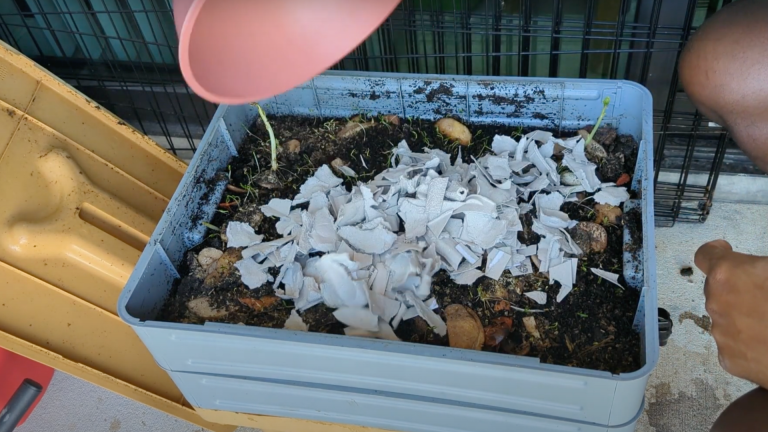Ever looked at an empty egg carton after breakfast and wondered what to do with it? You’re not alone. I’ve had the same question: Should it go in the trash, recycling, or compost?
The answer depends on the type of carton. Some break down easily and help your compost pile. Others don’t belong there at all.
In this blog, I’ll show you how to tell which ones are safe to compost, how to break them down at home, and what to avoid. I’ll also share a few easy ways to reuse cartons and what to do if composting isn’t an option.
Let’s clear up the confusion and make sure nothing ends up in the wrong bin.
Can You Compost Egg Cartons?
Yes, but only the right kind. Egg cartons come in different materials, and not all of them belong in your compost bin.
Paper, cardboard, and molded pulp cartons are compostable. These feel soft and fibrous. They’re made from recycled paper and fall into the “brown” category of compost, which balances wet food scraps.
Cartons made from plastic or Styrofoam should never go in the compost. The same goes for cartons with a glossy or waxed surface. These materials won’t break down and may affect your compost.
When in doubt, check the texture. If it rips like paper, it’s usually safe to compost.
How to Compost Egg Cartons Effectively at Home
You can compost paper egg cartons without much effort. Just follow these basic steps to help them break down faster.
Step 1: Tear or Cut into Small Pieces
Start by breaking the egg carton into smaller chunks. This helps it break down faster in your compost pile. Big pieces sit around too long, but small ones mix in easily and decompose quicker.
Tear it by hand, cut with scissors, or run it through a paper shredder. Aim for pieces smaller than your palm. This size holds moisture better and gives compost microbes a better shot at doing their job.
Soak carton pieces in water for 5–10 minutes before composting. This helps them break down faster, especially in dry weather. A quick spray works if you’re in a rush.
Step 2: Mix with Green Materials
Egg cartons count as “browns” in compost; they’re dry and carbon-rich. To break down properly, they need to be mixed with “greens,” which are wet and nitrogen-rich, like veggie scraps, fruit peels, or coffee grounds.
Aim for a 2:1 or 3:1 ratio of browns to greens. Too many browns will slow the composting. Too many greens can cause odor. Keep it balanced for best results.
Step 3: Monitor and Turn the Pile
Once your materials are mixed in, check the pile regularly. If it feels too dry, add a bit of water. If it smells bad, mix in more dry material and give it a good stir.
Turn the pile once a week using a shovel or compost fork. This adds air and helps everything break down evenly. With steady care, your egg cartons should compost in about two to four weeks, depending on conditions.
Recycling vs Composting: Which is Better for Egg Cartons?
Both options are useful, depending on what type of carton you have and what services your area offers.
| Option | Pros | Things to Consider |
|---|---|---|
| Composting | Returns material to the soil | Only works for paper-based cartons |
| Recycling | Keeps paper in use longer | Not all cities accept egg cartons |
| Reusing | No extra processing required | It may not work for every household |
If your area doesn’t recycle egg cartons, composting may be better. But if you can reuse them at home, that’s even more direct.
Other Ways to Reuse Egg Cartons
Egg cartons can be handy in many ways before they hit the bin.
- Seed starters: Add soil and seeds to each cup. Later, plant the cup directly in the ground.
- Bird feeders: Cut and hang them outside with seeds or fruit.
- Paint trays: Great for sorting paints, beads, or craft supplies.
- Fire starters: Fill each cup with dryer lint and wax for a homemade fire-starting block.
Tips for Choosing the Most Compost-Friendly Egg Carton
Not all egg cartons are created equal when it comes to composting. Some break down quickly and help your pile thrive. Others can clog things up or never decompose at all.
To make sure your carton helps, not hurts, your compost, take a moment to check the material. These tips will guide you:
- Choose cartons that are soft, fibrous, and dull, not smooth or shiny.
- Stick with plain paper or cardboard options that feel dry to the touch.
- Go for packaging with little to no printing, especially on the inside.
- Look for cartons marked with words like “100% recycled” or “safe for compost.”
- Avoid anything made of foam, plastic, or lined with wax or coatings.
These small checks can save you time later and keep your compost cleaner and more effective.
Conclusion
Thanks for sticking with me. Now you know which egg cartons can go into compost and how to use them the right way.
From tearing them up to keeping your pile balanced, the steps are simple once you’ve seen them in action.
If you’re still figuring out your compost routine, that’s okay. Every small step makes a difference. Just by asking questions and learning, you’re already helping reduce waste in a meaningful way.
Want more ideas? Check out other blogs for composting tools, easy materials to try, and practical ways to cut back on trash at home. I’ll keep sharing what works, so you can keep growing a better system, one step at a time.
















